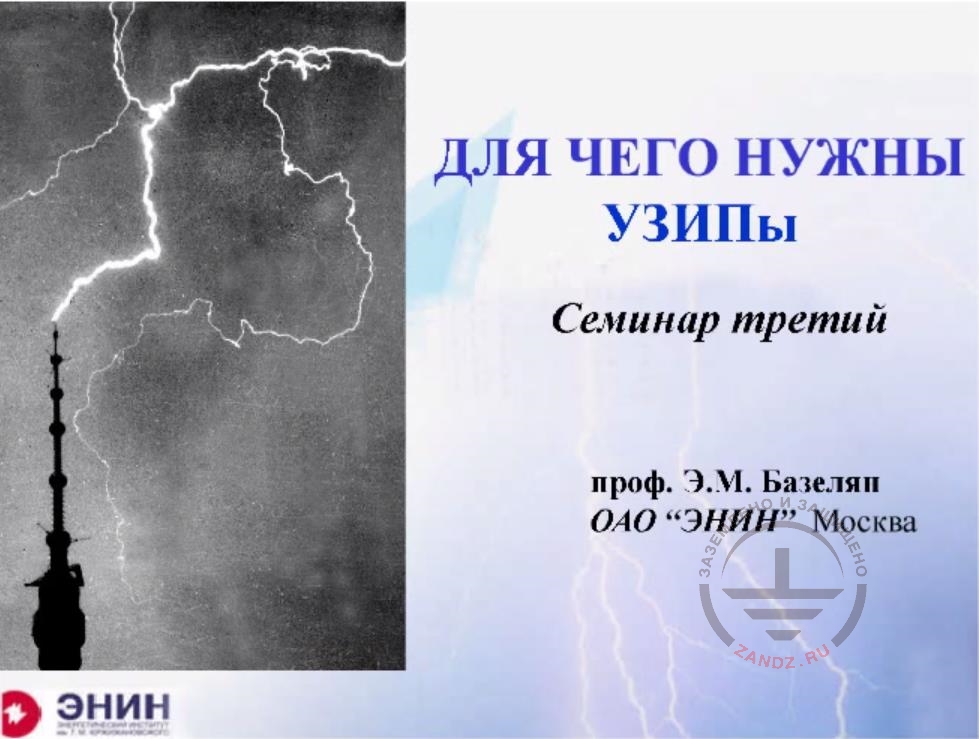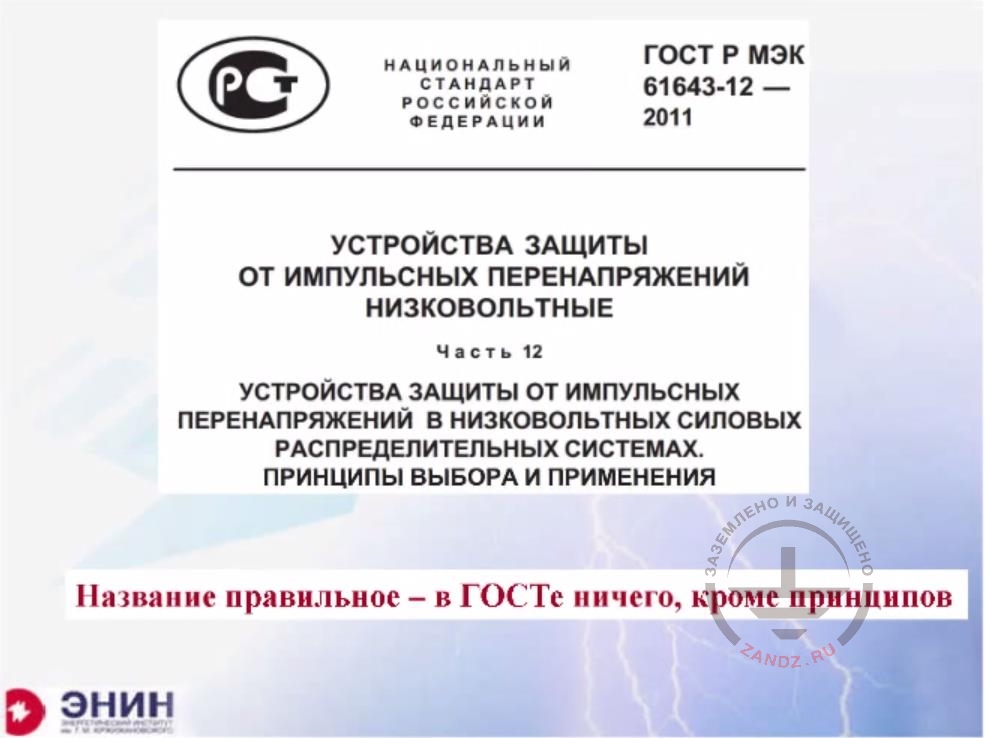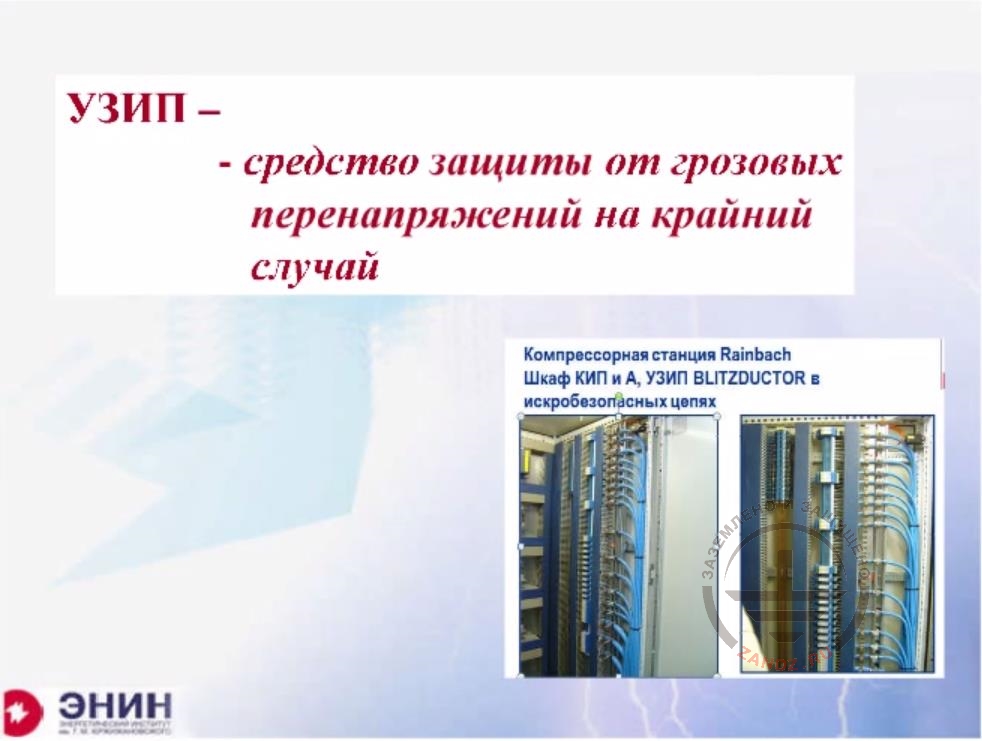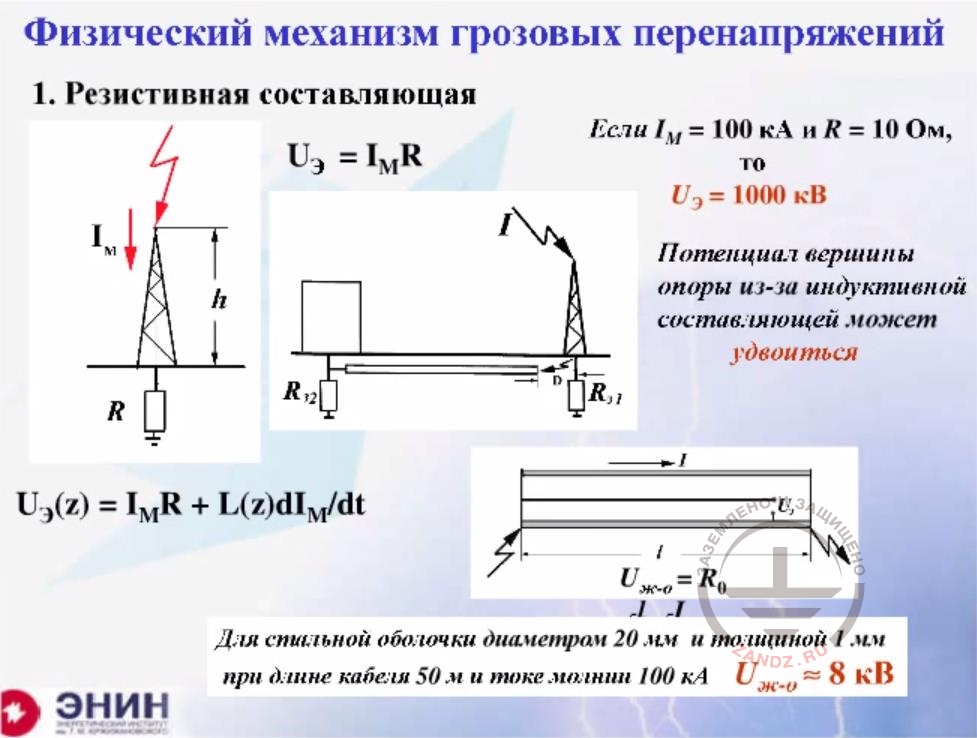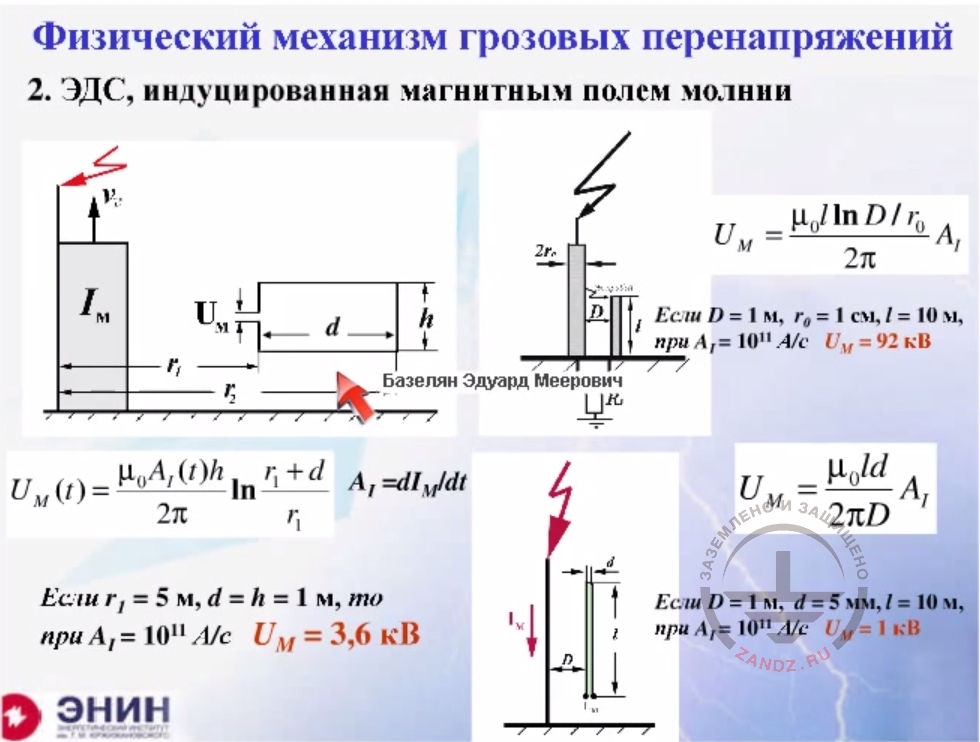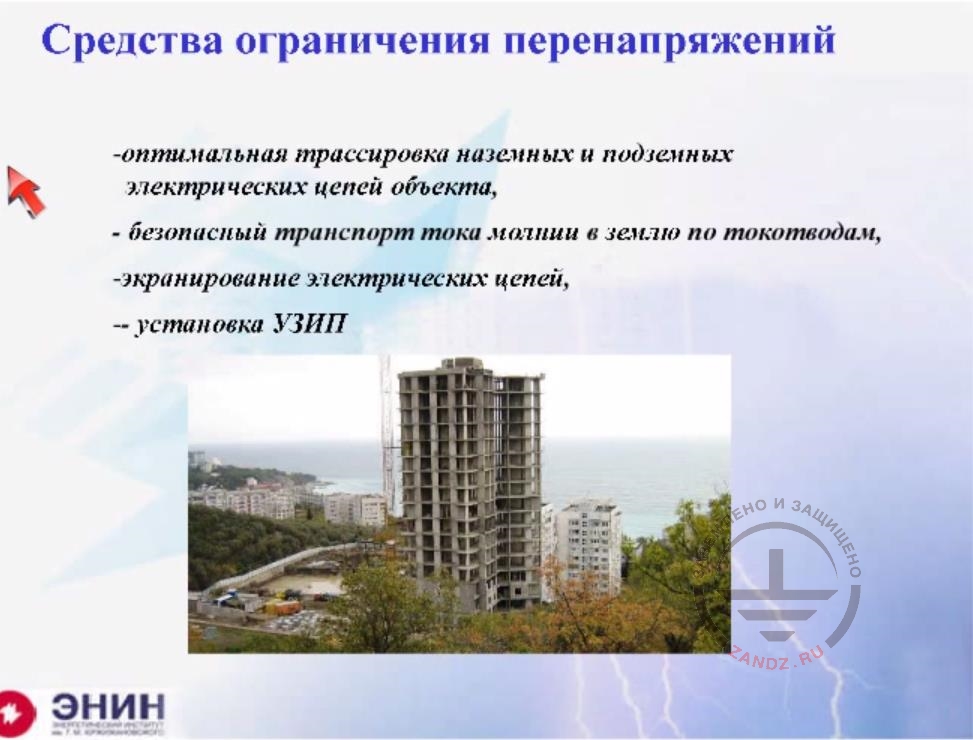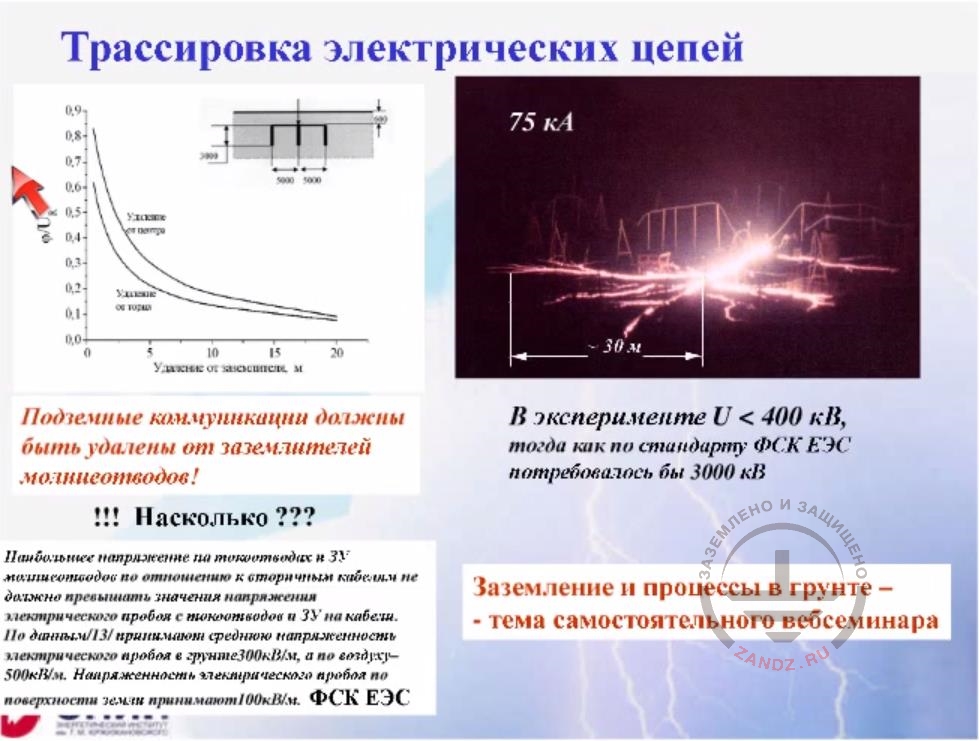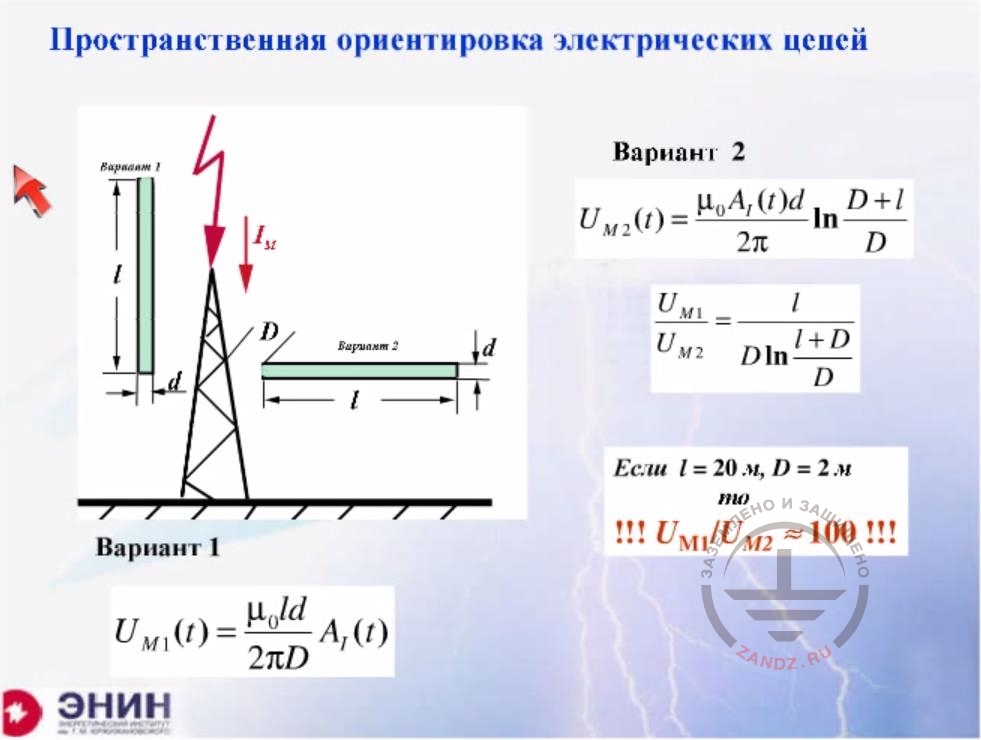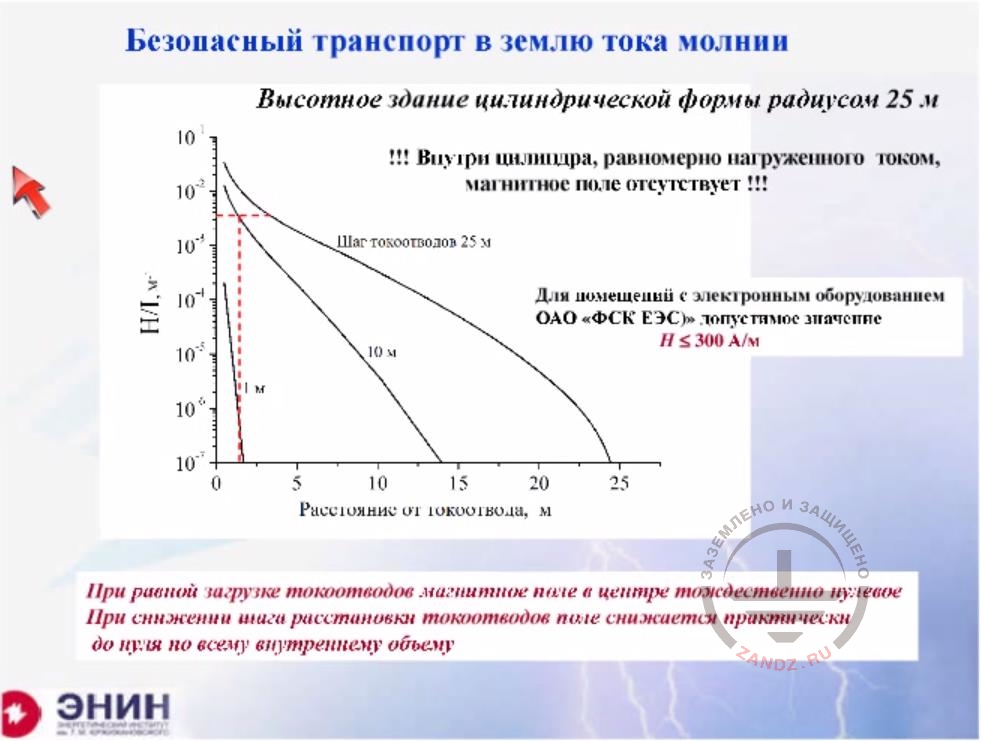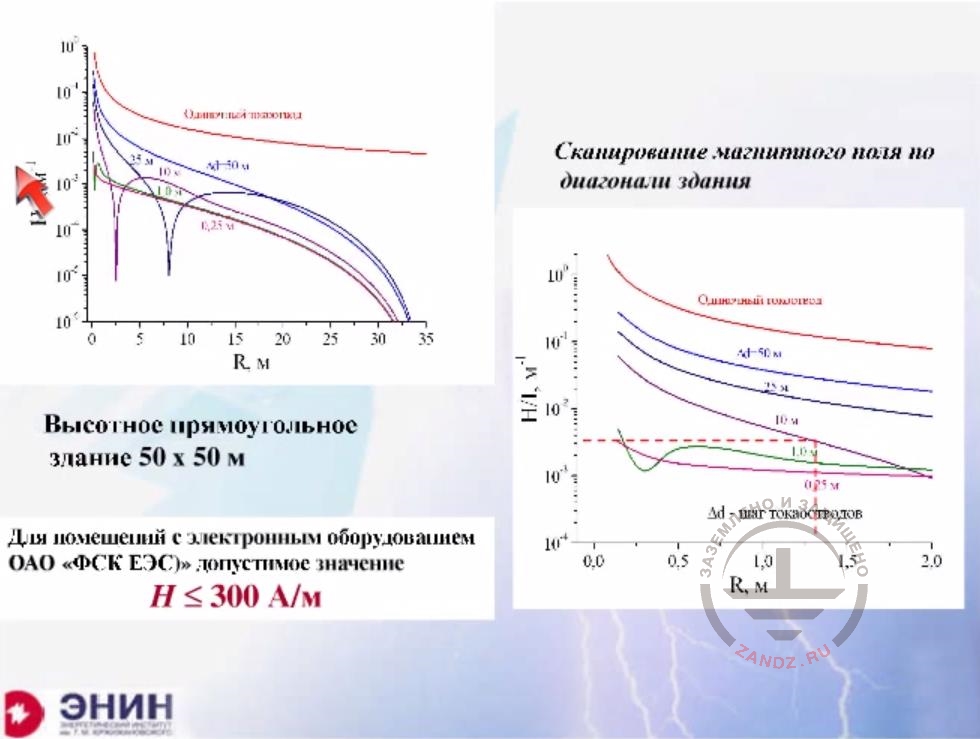The third webinar of a series "Grounding and lightning protection: issues and problems arising in the design"
(was hold on September 3, 2014 at 11:00 MSC)
We recommend watching the webinar with the streaming quality of 1080p in full-screen mode.
Let the question not seem rhetorical for you, but the abbreviation of the device itself shows that it is designed for surge protection. Manufacturing companies are trying to engraft the idea that all the design of interior lightning protection should come down to the correct alignment of the SPD in the circuits of the object to be protected from lightning surges. As a result, the number of such devices in modern technical facilities can be up to several thousand. For the business of lightning protection companies it is not bad, and in respect of the protected object the answer is not so simple. Any SPD is connected into an electrical circuit, performing well-defined technological functions. With a large number of such devices, the reliability of circuit's operation is determined by the reliability of the SPD, which is not absolute. This is hardly acceptable.
The installation of the SPD must be considered as an extremity to protect against electromagnetic pickup. It is reasonable to apply them when there are no possibilities of limiting electromagnetic effects of lightning at the expense of rational mounting of lightning rods, effective current drainage into the ground through the system of electrodes, rational harnessing of surface and underground electrical circuits of the object, first of all - chains of microelectronics. Electromagnetic shielding of critical circuits plays a very important role.
A correct choice of the SPD is not always an easy task. Today, a catalogue of SPDs in a modern actively operating company is typically a multi-page book of a large format. You must be able to correctly assess the main parameters of the protective device and its compatibility with the protected electrical circuit. Its design also plays a big role. In modern industrial facilities, SPDs need to be installed in hazardous locations, in aggressive chemical environments and at high pressures. All this should be considered by the designer.
Operational control of the current state of the SPD, also becomes a matter of study, especially at a large area of the protected object and at a large number of protective elements in its electrical circuits. Special automatic systems are offered for that purpose. It is important to assess the feasibility of their application, since material costs are assumed to be significant.
Webinar text. Page 1
Quick navigation through slides:
Page 1:
1.What are SPD designed for
2. GOST R IEC 61643-12-2011
3. SPD as a security tool against lightning surges in extreme cases
4. Physical mechanism of lightning overvoltage - a resistive component
5. Physical mechanism of lightning overvoltages - EMF induced by the magnetic field of the lightning
6. Surge suppression devices
7. Electrical circuit layout
8. Spatial orientation of electric circuits
9. Safe transportation of lightning current into the soil
10. Scanning the magnetic field along the diagonal of the building
11. Disturbance generating current goes across the shield
12. Disturbance generating current goes outside the shield
13. SPD operating principle
14. Basic physics
15. Zones protecting electrical and electronic systems from secondary effects of lightning
16. Selecting SPDs for a particular electrical circuit
17. Main parameters of SPDs
18. Rated withstanding surge for different categories of surge
19. List of parameters to select surge protective devices
20. Calculating lightning pulse current going through SPDs
21. The problem of parallel operation of an SPD
Estimated reading time: 1 hour 15 minutes
What do we need SPDs for?
Для чего нужны узипы – What do we need SPDs for?
Семинар Третий- the third seminar
Проф. Э.М. Базелян – Professor E.M. Bazelyan
ОАО «Энин» Москва – “Enin” JSC, Moscow
Hello, dear colleagues, it seems that we have started a new school year. Anyway, the last two weeks of my holiday, I've been trying to imagine an embedded system, the rules of SPDs use in electrical circuits of low voltage. And frankly speaking, my mood, when I came to this workshop may not be the best, but here is why.
GOST R IEC 61643-12-2011
Национальный стандарт Российской федерации – national standard of the Russian Federation
ГОСТ Р МЭК – GOST R IEC
Устройства защиты от импульсных перенапряжений - impulse overvoltage protective devices
Низковольтный – low-voltage
Часть 12 – part 12
Устройства защиты от импульсных перенапряжений в низковольтных силовых распределительных системах – Impulse overvoltage protective devices in low-voltage in power junction systems
Принципы выбора и применения – choice and application principles
Название правильное – в ГОСТе ничего, кроме принципов – The name is correct- there is nothing else in the GOST, except principles
In the future, GOST R, in 2011, which presents itself a translation of the standards of the International Electrotechnical Commission and the use of SPDs in low voltage networks into the Russian language. I read the Standard from cover to cover several times and found one thing: there are a lot of words, but the principle of the document - is like this: to discuss the principles and nothing more. The designer almost can do nothing expect the principles of this document. What principles we can talk about? The fact is that the principles of circuit calculation with losses are the usual methods of the theory of electrical circuits and there is no surprise here. And frankly speaking, nothing can be imagined here. I thought that maybe this GOST would give some equipment that could be used today on a computer and equipment- not at all. This document only contains words, nothing more. So what do different companies offer? Different companies praise their SPDs, saying that a SPD is happiness. Let's take two electricians because they limit everything necessary and unnecessary. And it is impossible to find information about when and how you can and should use SPDs. And then I decided to do something I should have done. I decided to present my point of view on this whole issue. But in the way I understand it. Of course, some may not agree with me, I am not discovering American here and this view is supported by many people. But, anyway, I want to tell you how I feel this problem and what is SPD for me?
SPD - protective device against lightning surges in extreme cases
Узип – средство защиты от грозовых перенапряжений на крайний случай – SPD protective measure from lightning surgess for extreme cases
Компрессорная станиция Rainbach – Rainbach compressor station
Шкаф КИП и А, УЗИП BLITZDUCTOR в искробезопасных цепях – Instrument cabinets, BLITZDUCTOR SPDs in sparkproof circuits
So, for me, a SPD is the ultimate thing to protect against storm surges of the lines about which we are talking. Lines of voltage 220 - 380 Volt. In my mind - it's like in fairy tales: somebody gives you a medicine in a bottle an says: drip three drops - a man will recover, drip ten - he will die. To my mind the attitude towards SPD should be as follows: it's a tool that can and should be applied only in case when you ran out of all other devices. Why? The explanation is very simple! SPD is put into an electric circuit.
It becomes a member of the chain and if there are many SPDs (for example, as shown here in the picture below). And when their number reaches many dozens and sometimes to hundreds and sometimes a thousand? Then the reliability of the circuit as a whole, stuffed with SPD becomes very much dependent on the reliability of these SPDs, and a SPD - is a normal electric-technical element, it has a service life, it can become degraded as it is written in the standard, that is change its characteristics and then the electrical circuit may be quite different. It won't perform its primary function, due to the fact that its reliability may be reduced by a SPD.
The physical mechanism of lightning overvoltages, resistive component
Физический механизм грозовых перенапряжений - physical mechanism from lightning surgess
-
Резистивная составляющая – resistive component
Если – if
И – and
То- then
Потенциал вершины опоры из-за индуктивной составляющей может удвоится – the potential of support’s top can be doubled due to the inductive component
Для стальной оболочки диаметром 20 мм и толщиной 1 мм при длине кабеля 50 м и токе молнии 100 кА – for a steel shell 20 mm in diameter and 1 mm thick with the length of the cable of 50 m and lightning current of 100 kA.
Let's see, about what surges we can talk in low voltage networks. The nature of these surges is twofold. The first - the lightning current flows through some resistance and then there happens a voltage drop on this resistance. It occurs at the resistance itself, it occurs in the inductance of the electric circuit. And these two components may lead to the fact that the value of this surge becomes great. For example, if I'm going to calculate the third level of lightning protection and take the current of 100 kilo Amperes, then ground resistance of 10 Ohm is a very low grounding resistance for lightning rods. The overvoltage rises to 1,000 kV, only for grounding resistance. If to add a voltage drop on the inductive component, this value can be doubled. If the current partially enters the line (for example) through an underground cable, in this case the overvoltage value, of course, will be smaller. Still, this value will be at the level of tens of kilovolts. Finally, if the current flows through the cable sheath, as shown here below (very inconvenient). My pointer doesn't know, I don't know. Well, ok, let's forget about it. If the current flows through the cable sheath, the surges will occur due to sheath resistance.
Physical mechanism of lightning surges, EMF induced by the magnetic field of lightning
Физический механизм грозовых перенапряжений - physical mechanism of lightning surges
This is the value which should always be considered. The second value, surge component is associated with the magnetic field of lightning. If the current flows somewhere through the lightning channel or through the lightning rod, through the ground electrode system, if it flows through the down conductor. No matter where it flows, but the next thing is important: that a magnetic field that will permeate any contour will in this case become a surge source. Here, on the left you see a contour that is near the down conductor, through which the lightning current flows. In this case, the value of surge which occurs in the contour of one square meter in size is approximately 3.5 - 4 kilovolts. If the current flows through the down conductor and a man is standing near, then the voltage between the contour and that man may reach tens of kilovolts, providing that the distance between the current flow and the man is about one meter. Finally, if the current flows through the down conductor and there is very narrow loop of two wires near, as shown here below, in this case the overvoltage is also approximately at the level of one kilovolt. That is, in any case, no matter where you are, you have to use surge protective devices. So, before we talk about if you take or won't take a grounding device, take or not take a SPD, think first about the following: what other means to limit overvoltage you have?
Surge suppression means
Средства ограничения напряжений – surge suppression means
Оптимальная трассировка наземных и подземных электрических цепей объекта – optimal harnessing of aboveground and underground electrical circuits of the object,
Безопасный транспорт тока молнии в землю по токоотводам – safe transportation of lightning current to the ground through down conductors
Экранирование электрических цепей – shielding of electric circuits
Установка УЗИП – installation of SPDs
These surge suppression means, which I have listed, they come down to this: firstly, you need to properly make the harnessing of surface and underground electrical circuits. We must develop an electrical circuit in such a way to have a minimal voltage at the lightning current spreading. Secondly, you need to provide a most secure transportation of the lightning current from the point of impact to the ground through down conductors and this means, I'll show you later, is extremely effective. Finally, the third point; you need to screen electrical circuits. This screening is extremely effective in some cases. And finally, if you ran out of all these means but the surge is still high enough, then why not to think about using a SPD.
Harnessing of electrical circuits
Трассировка электрических цепей – harnessing of electric circuits
Diagram on the left – удаление от центра – distance from the center
Удаление от (не вижу ) – distance from ()
Удаление от заземлителя – distance from ground electrode system, m
Подземные коммуникации должны быть удалены от заземлителей молниеотводов! – Underground utilities should be distanced from lightning rod ground electrode systems!
Насколько? – how far??
В эксперименте U<400…… In the experiment U< 400 kV, whereas according to FGC UES standard, 3000 kV would be required.
Заземление и процессы в грунте – тема самостоятельного вебинара – grounding and processes in the ground is a topic for another webinar.
Наибольшее напряжение …..- The greatest voltage on down conductors and grounding devices of lightning rods in relation to secondary cables should not exceed voltage values of electric breakdown from down conductors and grounding devices to wires. According to /13/ average intensity of electric breakdown in the soil is considered as 300 kV/m, and in the air – 500 kV/m. The intensity of electric breakdown over the ground surface is considered as 100 kV/m.
Let's see what can be achieved by means, without SPDs, in order to minimize their number. I understand that maybe the companies that advertise SPDs may not approve me but let's first of all think about electric circuit safety, move the underground utilities as far as possible from the ground electrode systems and lightning rods. Here on the left you see the potential in relation to the potential of a lightning rod. Even at the distance of 15 meters - this voltage is at the level of 20% of grounding resistance of lightning rods. What is 20%? If you have 10 Ohms, if your current is 100 kA, then at the distance of 15 meters from the lightning rods you have 20% from 1000 kV - it will be 200 kilovolts. It is a high voltage, that is, you need to drag the cable away from the lightning rod ground electrode system as far as possible. How far should it be put? What standards should we follow here? Frankly speaking, I have not found any standards in this respect other than those offered by the Federal Grid Company. The Federal Grid Company says that if the distance between the lightning rod and grounding cable represents some length, wind blasts for each length are of 300 kilovolts. To be honest, where this figure of 300 kilovolts per meter appeared from, I do not know. But I suspect that this figure was obtained in small laboratory spaces. What does the federal document of the Federal Grid Company say next? If you have a breakdown not in the soil but on the surface, in this case, you instead of 300 kW (we lost connection). I've been seriously working on the breakdowns on soil surface.
On the right, you see a picture which shows the breakdown going along the soil surface when the current is 75 kA. These experiments were carried out in the Institute of Experimental Physics. Spark channels on the surface have a length of 30 m. If you take 100 kW per meter, which is written in the FGC, then you will need for such a channel -30 multiplied by 100 will be 3000 kW, 3 000 000 W. In fact, the voltage in this experiment was only 400 kW. How to harmonize experimental data and currently existing standards, I don't really understand. But I understand the following thing: that we need to hold a web seminar on grounding in soils. I suggest, if you have no objections, to devote the next workshop to the processes in soil.
But in any case, if you perform a simple measure, and this simple measure will be to remote the cables from the underground ground electrode systems of lightning rods and from ground electrode systems in general, you'll achieve quite a good effect.
Spatial orientation of electric circuits
Пространственная ориентировка электрических цепей – spatial orientation of electric circuits
Вариант 1 –variant 1
Если – if
То - then
Now let's talk about spatial orientation of electric circuit. The spatial orientation of electric circuits, it is associated with the following: if you have a contour that is induced (EMF) parallel to the current path and perpendicular to the current path, your calculations will be carried out according to fundamentally different mathematical expressions. As a result, the overvoltage at a parallel contour arrangement will be much higher than at the perpendicular. It is quite an obvious phenomenon and to feel the figures, I will show you an example: Conductor length is 20 m; distance from the contour is 2 m. In this case, if instead of the parallel circuit connection, you do it perpendicular, you will reduce the overvoltage exactly to two orders of magnitude, hundredfold.
Safe transportation of lightning current into the ground
Безопасный транспорт тока молнии в землю –safe transportation of lightning current into the ground
Высотное здание цилиндрической формы радиусом 25 м – high-rise building of cylindrical form 25 m in radius
Внутри цилиндра, равномерно нагруженного током, магнитное поле отсутствует – There is no magnetic field inside the cylinder equally loaded with current
Шаг токоотводов 25 м – the distance between the down conductors is 25 m
Для помещений с электронным оборудованием ОАО «ФСК ЕЭС» допустимое значение Н<= 300 А/м – for premises with electric equipment of “FGC UES” JSC the accepted value is 300 <= A/m
Расстояние от токоотвода, м – distance from the down conductor, m
При равной загрузке токоотводов – At the equal loading of down conductors, magnetic field in the center is identical to null.
При снижении шага- at the reduction of the distance between the down conductors the field reduces almost to zero on the overall interior volume
The third point. The third point - is very important for practice. The thing is that by distributing the lightning current through a large number of down conductors, you greatly reduce the value of the magnetic field inside of the building in which you are working. I will give you two examples. The first example -a simply perfect situation. Imagine that you have a building of round shape. If your building is of a round shape, then increasing the number of down conductors, you can reduce the magnetic field inside the building almost to zero. Question - how much is allowed? I have not found the figures anywhere except the Federal Grid Company. The Federal Grid Company considers the value of 300 A per meter acceptable in their buildings - magnetic field. This red like shows to what it will correspond. It will correspond to the fact, that your electrical circuit will be located at a distance of 2 meters or further from the down conductor. It is not a problem to make such conditions, because even 10 down conductors will provide such a thing.
Scanning of the magnetic field along the diagonal of the building
Высотное прямоугольное здание 50*50 м – high-rise rectangular building
Сканирование магнитного поля по диагонали здания – magnetic field scanning along the diagonal of the building
Для помещений с электронным оборудованием ОАО «ФСК ЕЭС» допустимое значение Н<= 300 А/м – for premises with electric equipment of “FGC UES” JSC the accepted value is 300 <= A/m
If you switch from a perfectly round building to a building of practical shape, for example, rectangular, you have a magnetic field will be distributed depending on the number of down conductors, in a very complicated way. But on the right of the image, I see a thing: I see that if the distance between down conductors is for example 10 m, then at the distance of 1.5 m from this down conductor , the field will be less than 300 A per meter, which is considered acceptable. In other words, if you start to increase the number of down conductors and there will be more than ten of them. (Finally, I've got the pointer, but it still doesn't work). If the distance between the down conductors will be 10 m or less, and the distance of 10 meters is recommended for the first level of lightning protection, then the electric field strength is lower than the one recommended by the normative documents, and you (I hope) will get manage without any SPD.
Next Page >>
Slides from 11 to 21
Useful materials for designers:
- Webinars with the leading industry experts
- Everything for the calculation of grounding and lightning protection
- Useful materials: articles, recommendations, examples
Related Articles:
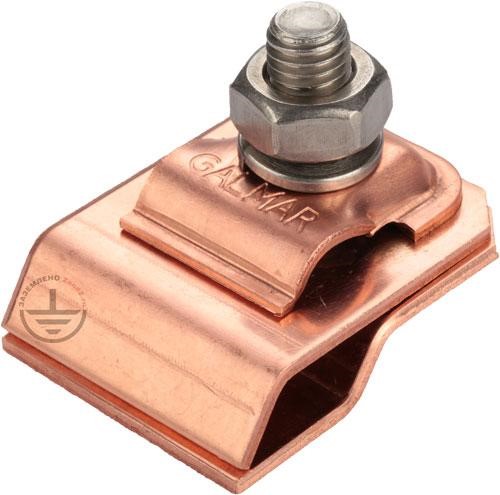 Clamp on the gutter for the down conductor (copper)
Clamp on the gutter for the down conductor (copper)




